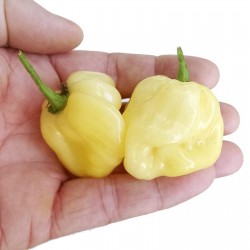Menu
-
MenuBack
- Home
-
Categories
-
-
Categories
-
Vegetable Seeds
-
Varieties by Country
- Varieties from Armenia
- Varieties from BiH
- Varieties from Croatia
- Varieties from France
- Varieties from Germany
- Varieties from Greece
- Varieties from Hungary
- Varieties from India
- Varieties from Italy
- Varieties from Japan
- Varieties from North Macedonia
- Varieties from Peru
- Varieties from Russia
- Varieties from Serbia
- Varieties from Slovenia
- Varieties from Spain
- Varieties from Thailand
- Varieties from Turkey
- Varieties from USA
- Tomato Seeds
- Corn Seeds
- Gourd family
- Bean family
- Cucumber Seeds
- Pepper Seeds
- Carrot family
- Onion family
- Lettuce Seeds
- Potato family
- Cabbage family
- Radish Seeds
- Beetroot family
- Watermelon Seeds
- Melon Seeds
- Cauliflower Seeds
- Sunflower family
-
Varieties by Country
- Fruit Seeds
- Chili - Habanero Seeds
- Medicinal Herb Seeds
- Climbing Plants Seeds
- Trees Bonsai Seeds
- Palm Seeds
- Ornamental Grasses Seeds
- Tobacco Seeds
-
Vegetable Seeds
-
-
-
-
- NEW PRODUCTS
- Create account
- Delivery - Payment
- FAQ
Last Product Reviews
Out of the two seeds, one germinated and the other one was dead and floatin...
By
 Riikka H on 07/03/2024
Riikka H on 07/03/2024
Verified Purchase
There are 130 products.
Showing 31-45 of 130 item(s)

Giant plant (with giant fruits)

Coming Soon
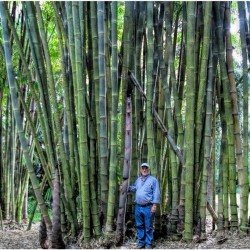
Giant Thorny Bamboo Seeds...
Price
€1.60
(SKU: B 5)
Seeds Gallery EU,
5/
5
<meta http-equiv="Content-Type" content="text/html; charset=UTF-8" />
<div id="idTab1" class="rte">
<h2 id="short_description_content" class="rte align_justify"><span style="font-size: 14pt;"><strong>Giant Thorny Bamboo Seeds (Bambusa arundinacea)</strong></span></h2>
<h2 class="rte align_justify"><span style="color: #ff0000; font-size: 14pt;"><strong>Price for Package of 5 seeds.</strong></span></h2>
<p>Bambusa bambos also known as Giant Thorny Bamboo or Indian Thorny Bamboo, is a species of tropical dense clumping bamboo native to Southeast Asia. This bamboo species was previously named Bambusa arundinacea and is often used for construction purposes.</p>
<p><strong>Culms: </strong>The fast growing, strong woody culms of <em>Bambusa bambos </em>have an average diameter between 10-18 cm, and are between 20-30 m tall (although the tallest recorded culm measured 40 m). The internodes are dark green colored with very thick walls. Nodes are slightly swollen and some lower nodes produce short aerial roots.</p>
<p><strong>Branches: </strong>Nodes contain a central dominant branch with one or two lateral branches and are often spine-like. Thorny lower branches are long and wiry, and usually bent towards the ground. The upper leafy branches produce a fan like plume and bearing small spines.</p>
<p><strong>Leaves: </strong>Leaves are lance-shaped with a long-pointed tip. They measure between 15-30 cm long and 8-15 mm broad, with about 10 leaves in each complement.</p>
<p><strong>Seeds: </strong>This bamboo species may flower every 30-50 years. Gregarious flowering was last reported in the early 90's (1991-1995) where single clumps gave about 50-100 kg of seeds (70,000 to 85,000 seeds per kilogram). <em>Bambusa bambos </em>seeds are generally viable for a period of 6-8 months.</p>
<p><strong>Habitat: </strong><em>Bambusa bambos </em>prefers a humid tropical climate and grows best along river banks or river valleys with a rich, moist soil. It reaches its best development in moist deciduous forests up to an altitude of 1,250 m and receiving nearly 2,000-2,500 mm rainfall a year. In flat alluvial soil, the culms are reported to attain a height of 25-30 m and a diameter of 20-25 cm.</p>
<p><strong>Uses: </strong>Culms are used for house construction, scaffolding, rafters, thatching and roofing, handicrafts and art objects, basket making, bows and arrows, furniture, floating timber and rafting, cooking utensils and fencing. The raw material of this bamboo is also an important source for paper pulp and panel products. Shoots and seeds are edible and leaves are used as fodder and medicine.</p>
<p><strong>Mechanical properties:</strong> Fibre stress varies between 18.3-26.5 N/mm2, modulus of rupture is 35-39.3 N/mm2, modulus of elasticity 1.5-4.4 kN/mm2 and maximum crushing stress is 39.1-47 N/mm2.</p>
<p><strong>Origin: </strong><em>Bambusa bambos</em> is native to Southeast Asia, to be more specific: India, Pakistan, Sri Lanka, Bangladesh, Burma, Thailand, Laos, Kampuchea, Vietnam and China.</p>
<p>In India this species occupies 15% of all bamboo forests. It was also introduced to many other tropical countries and regions; including New Guinea and Pacific Islands, northern Australia and New Zealand, tropical Africa and Madagascar, Central and South America (including Caribbean Islands), Mexico and Southern USA (Florida).</p>
<table cellspacing="0" cellpadding="0" border="1">
<tbody>
<tr>
<td colspan="2" width="100%" valign="top">
<h3 align="center"><span style="color: #008000;"><strong>Sowing Instructions</strong></span></h3>
</td>
</tr>
<tr>
<td valign="top" nowrap="nowrap">
<p align="center"><span style="color: #008000;"><strong>Propagation:</strong></span></p>
</td>
<td valign="top">
<p align="center"><span style="color: #008000;">Seeds</span></p>
</td>
</tr>
<tr>
<td valign="top" nowrap="nowrap">
<p align="center"><span style="color: #008000;"><strong>Pretreat:</strong></span></p>
</td>
<td valign="top">
<p align="center"><span style="color: #008000;">0</span></p>
</td>
</tr>
<tr>
<td valign="top" nowrap="nowrap">
<p align="center"><span style="color: #008000;"><strong>Stratification:</strong></span></p>
</td>
<td valign="top">
<p align="center"><span style="color: #008000;">0</span></p>
</td>
</tr>
<tr>
<td valign="top" nowrap="nowrap">
<p align="center"><span style="color: #008000;"><strong>Sowing Time:</strong></span></p>
</td>
<td valign="top">
<p align="center"><span style="color: #008000;">all year round</span></p>
</td>
</tr>
<tr>
<td valign="top" nowrap="nowrap">
<p align="center"><span style="color: #008000;"><strong>Sowing Depth:</strong></span></p>
</td>
<td valign="top">
<p align="center"><span style="color: #008000;">Needs Light to germinate! Just sprinkle on the surface of the substrate + gently press</span></p>
</td>
</tr>
<tr>
<td valign="top" nowrap="nowrap">
<p align="center"><span style="color: #008000;"><strong>Sowing Mix:</strong></span></p>
</td>
<td valign="top">
<p align="center"><span style="color: #008000;">Coir or sowing mix + sand or perlite</span></p>
</td>
</tr>
<tr>
<td valign="top" nowrap="nowrap">
<p align="center"><span style="color: #008000;"><strong>Germination temperature:</strong></span></p>
</td>
<td valign="top">
<p align="center"><span style="color: #008000;">25-30°C</span></p>
</td>
</tr>
<tr>
<td valign="top" nowrap="nowrap">
<p align="center"><span style="color: #008000;"><strong>Location:</strong></span></p>
</td>
<td valign="top">
<p align="center"><span style="color: #008000;">bright + keep constantly moist not wet</span></p>
</td>
</tr>
<tr>
<td valign="top" nowrap="nowrap">
<p align="center"><span style="color: #008000;"><strong>Germination Time:</strong></span></p>
</td>
<td valign="top">
<p align="center"><span style="color: #008000;">1 - 8 weeks</span></p>
</td>
</tr>
<tr>
<td valign="top" nowrap="nowrap">
<p align="center"><span style="color: #008000;"><strong>Watering:</strong></span></p>
</td>
<td valign="top">
<p align="center"><span style="color: #008000;">Water regularly during the growing season</span></p>
</td>
</tr>
<tr>
<td valign="top" nowrap="nowrap"> </td>
<td valign="top">
<p align="center"><br /><span style="color: #008000;"> <em>Copyright © 2012 Seeds Gallery - Saatgut Galerie - Galerija semena. </em><em>All Rights Reserved.</em></span></p>
</td>
</tr>
</tbody>
</table>
<p> </p>
</div>
B 5 (5 S)


Giant plant (with giant fruits)

Coming Soon
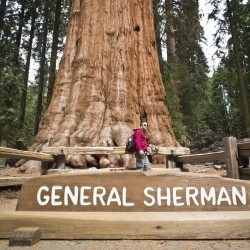
Giant Sequoia Seeds Bonsai
Price
€2.35
(SKU: T 16)
Seeds Gallery EU,
5/
5
<div id="more_info_sheets" class="sheets align_justify">
<div id="idTab1" class="rte">
<h2><span style="font-size: 14pt;"><strong>Giant Sequoia Seeds Bonsai (Sequoiadendron giganteum)</strong></span></h2>
<h2><span style="color: #ff0000; font-size: 14pt;"><strong>Price for Package of 5 seeds.</strong></span></h2>
<p><i style="font-size: 14px;"><b>Sequoiadendron giganteum</b></i><span style="font-size: 14px;"> </span><span style="font-size: 14px;">(</span><b style="font-size: 14px;">giant sequoia</b><span style="font-size: 14px;">; also known as</span><span style="font-size: 14px;"> </span><b style="font-size: 14px;">giant redwood</b><span style="font-size: 14px;">,</span><span style="font-size: 14px;"> </span><b style="font-size: 14px;">Sierra redwood</b><span style="font-size: 14px;">,</span><span style="font-size: 14px;"> </span><b style="font-size: 14px;">Sierran redwood</b><span style="font-size: 14px;">,</span><span style="font-size: 14px;"> </span><b style="font-size: 14px;">Wellingtonia</b><span style="font-size: 14px;"> </span><span style="font-size: 14px;">or simply</span><span style="font-size: 14px;"> </span><b style="font-size: 14px;">big tree</b><span style="font-size: 14px;">—a nickname also used by</span><span style="font-size: 14px;"> </span>John Muir<sup id="cite_ref-2" class="reference">[2]</sup><span style="font-size: 14px;">) is the sole living species in the genus</span><span style="font-size: 14px;"> </span><i style="font-size: 14px;">Sequoiadendron</i><span style="font-size: 14px;">, and one of three species of</span><span style="font-size: 14px;"> </span>coniferous<span style="font-size: 14px;"> </span>trees<span style="font-size: 14px;"> </span><span style="font-size: 14px;">known as</span><span style="font-size: 14px;"> </span>redwoods<span style="font-size: 14px;">, classified in the family</span><span style="font-size: 14px;"> </span>Cupressaceae<span style="font-size: 14px;"> </span><span style="font-size: 14px;">in the subfamily</span><span style="font-size: 14px;"> </span>Sequoioideae<span style="font-size: 14px;">, together with</span><span style="font-size: 14px;"> </span><i style="font-size: 14px;">Sequoia sempervirens</i><span style="font-size: 14px;"> </span><span style="font-size: 14px;">(coast redwood) and</span><span style="font-size: 14px;"> </span><i style="font-size: 14px;">Metasequoia glyptostroboides</i><span style="font-size: 14px;"> </span><span style="font-size: 14px;">(dawn redwood). Giant sequoia specimens are the most massive trees on Earth.</span><sup id="cite_ref-usda_3-0" class="reference">[3]</sup><span style="font-size: 14px;"> </span><span style="font-size: 14px;">The common use of the name</span><span style="font-size: 14px;"> </span><i style="font-size: 14px;">sequoia</i><span style="font-size: 14px;"> </span><span style="font-size: 14px;">usually refers to</span><span style="font-size: 14px;"> </span><i style="font-size: 14px;">Sequoiadendron giganteum</i><span style="font-size: 14px;">, which occurs naturally only in groves on the western slopes of the</span><span style="font-size: 14px;"> </span>Sierra Nevada<span style="font-size: 14px;"> </span><span style="font-size: 14px;">Mountains of California.</span></p>
<div>
<p>The etymology of the genus name has been presumed—initially in<span> </span><i>The Yosemite Book</i><span> </span>by<span> </span>Josiah Whitney<span> </span>in 1868<sup id="cite_ref-cnps1_4-0" class="reference">[4]</sup>—to be in honor of<span> </span>Sequoyah<span> </span>(1767–1843), who was the inventor of the<span> </span>Cherokee syllabary.<sup id="cite_ref-natcomp_5-0" class="reference">[5]</sup><span> </span>An etymological study published in 2012, however, concluded that the name was more likely to have originated from the Latin<span> </span><i>sequi</i><span> </span>(meaning<span> </span><i>to follow</i>) since the number of seeds per cone in the newly-classified genus fell in mathematical sequence with the other four genera in the suborder.<sup id="cite_ref-cnps2_6-0" class="reference">[6]</sup></p>
<h2><span class="mw-headline" id="Description">Description</span></h2>
<div class="thumb tleft">
<div class="thumbinner"><img alt="" src="https://upload.wikimedia.org/wikipedia/commons/thumb/2/20/Daniel_Fuchs.CC-BY-SA.Sequoiadendron_giganteum.jpg/220px-Daniel_Fuchs.CC-BY-SA.Sequoiadendron_giganteum.jpg" width="220" height="150" class="thumbimage">
<div class="thumbcaption">
<div class="magnify"></div>
Leaves of<span> </span><i>Sequoiadendron giganteum</i></div>
</div>
</div>
<p>Giant sequoia specimens are the most massive individual trees in the world.<sup id="cite_ref-usda_3-1" class="reference">[3]</sup><span> </span>They grow to an average height of 50–85 m (164–279 ft) with trunk diameters ranging from 6–8 m (20–26 ft). Record trees have been measured at 94.8 m (311 ft) tall. Trunk diameters of 17 m (56 ft) have been claimed via research figures taken out of context.<sup id="cite_ref-Flint_2002_7-0" class="reference">[7]</sup><span> </span>The specimen known to have the greatest<span> </span>diameter at breast heightis the<span> </span>General Grant tree<span> </span>at 8.8 m (28.9 ft).<sup id="cite_ref-8" class="reference">[8]</sup><span> </span>Between 2014 and 2016, specimens of<span> </span>coast redwood<span> </span>were found to have greater trunk diameters than all known giant sequoias.<sup id="cite_ref-mdvaden.com_9-0" class="reference">[9]</sup><span> </span>The trunks of coast redwoods taper at lower heights than those of giant sequoias which have more columnar trunks that maintain larger diameters to greater heights.</p>
<p>The oldest known giant sequoia is 3,500 years old based on<span> </span>dendrochronology. Giant sequoias are among<span> </span>the oldest living organisms<span> </span>on Earth. Giant sequoia bark is fibrous, furrowed, and may be 90 cm (3 ft) thick at the base of the columnar trunk. The bark provides significant protection from fire damage. The leaves are<span> </span>evergreen, awl-shaped, 3–6 mm (<span class="frac nowrap"><sup>1</sup>⁄<sub>8</sub></span>–<span class="frac nowrap"><sup>1</sup>⁄<sub>4</sub></span> in) long, and arranged spirally on the shoots.</p>
<div class="thumb tleft">
<div class="thumbinner"><img alt="" src="https://upload.wikimedia.org/wikipedia/commons/thumb/e/e4/Sequoiadendron_giganteum_MHNT.BOT.2004.0.191.jpg/220px-Sequoiadendron_giganteum_MHNT.BOT.2004.0.191.jpg" width="220" height="199" class="thumbimage">
<div class="thumbcaption">
<div class="magnify"></div>
Giant sequoia cones and seed</div>
</div>
</div>
<p>The giant sequoia regenerates by<span> </span>seed. The seed<span> </span>cones<span> </span>are 4–7 cm (<span class="frac nowrap">1<span class="visualhide"> </span><sup>1</sup>⁄<sub>2</sub></span>–3 in) long and mature in 18–20 months, though they typically remain green and closed for as long as 20 years. Each cone has 30–50 spirally arranged scales, with several seeds on each scale, giving an average of 230 seeds per cone. Seeds are dark brown, 4–5 mm (0.16–0.20 in) long, and 1 mm (0.04 in) broad, with a 1-millimeter (0.04 in) wide, yellow-brown wing along each side. Some seeds shed when the cone scales shrink during hot weather in late summer, but most are liberated by insect damage or when the cone dries from the heat of fire. Young trees start to bear cones after 12 years.</p>
<p>Trees may produce sprouts from their stumps subsequent to injury, until about 20 years old; however, shoots do not form on the stumps of mature trees as they do on coast redwoods. Giant sequoias of all ages may sprout from their<span> </span>boles<span> </span>when branches are lost to fire or breakage.</p>
<p>A large tree may have as many as 11,000 cones. Cone production is greatest in the upper portion of the canopy. A mature giant sequoia disperses an estimated 300–400 thousand seeds annually. The winged seeds may fly as far as 180 m (590 ft) from the parent tree.</p>
<p>Lower branches die readily from being shaded, but trees younger than 100 years retain most of their dead branches. Trunks of mature trees in groves are generally free of branches to a height of 20–50 m (70–160 ft), but solitary trees retain lower branches.</p>
<h2><span class="mw-headline" id="Biology">Biology</span></h2>
<p>Because of its size, the tree has been studied for its water pull. Water from the roots can be pushed up only a few meters by<span> </span>osmotic pressure<span> </span>but can reach extreme heights by using a system of branching<span> </span>capillarity(capillary action) in the tree's<span> </span>xylem<span> </span>(the water tubules) and sub-pressure from evaporating water at the leaves.<sup id="cite_ref-10" class="reference">[10]</sup><span> </span>Sequoias supplement water from the soil with fog, taken up through<span> </span>air roots, at heights to where the root water cannot be pulled.</p>
<h2><span class="mw-headline" id="Distribution">Distribution</span></h2>
<div class="thumb tright">
<div class="thumbinner"><img alt="" src="https://upload.wikimedia.org/wikipedia/commons/thumb/6/69/A014%2C_Sequoia_National_Park%2C_California%2C_USA%2C_1998.jpg/220px-A014%2C_Sequoia_National_Park%2C_California%2C_USA%2C_1998.jpg" width="220" height="147" class="thumbimage">
<div class="thumbcaption">
<div class="magnify"></div>
The<span> </span>Generals Highway<span> </span>passes between giant sequoias in Sequoia National Park</div>
</div>
</div>
<p>The natural distribution of giant sequoias is restricted to a limited area of the western<span> </span>Sierra Nevada,<span> </span>California. They occur in scattered groves, with a total of 68 groves (see<span> </span>list of sequoia groves<span> </span>for a full inventory), comprising a total area of only 144.16 km<sup>2</sup><span> </span>(35,620 acres). Nowhere does it grow in pure stands, although in a few small areas, stands do approach a pure condition. The northern two-thirds of its range, from the<span> </span>American River<span> </span>in<span> </span>Placer County<span> </span>southward to the<span> </span>Kings River, has only eight disjunct groves. The remaining southern groves are concentrated between the Kings River and the Deer Creek Grove in southern<span> </span>Tulare County. Groves range in size from 12.4 km<sup>2</sup><span> </span>(3,100 acres) with 20,000 mature trees, to small groves with only six living trees. Many are protected in<span> </span>Sequoia<span> </span>and<span> </span>Kings Canyon National Parks<span> </span>and<span> </span>Giant Sequoia National Monument.</p>
<p>The giant sequoia is usually found in a humid climate characterized by dry summers and<span> </span>snowy<span> </span>winters. Most giant sequoia groves are on granitic-based residual and<span> </span>alluvial<span> </span>soils. The elevation of the giant sequoia groves generally ranges from 1,400–2,000 m (4,600–6,600 ft) in the north, to 1,700–2,150 metres (5,580–7,050 ft) to the south. Giant sequoias generally occur on the south-facing sides of northern mountains, and on the northern faces of more southerly slopes.</p>
<p>High levels of reproduction are not necessary to maintain the present population levels. Few groves, however, have sufficient young trees to maintain the present density of mature giant sequoias for the future. The majority of giant sequoias are currently undergoing a gradual decline in density since European settlement.</p>
<p>While the present day distribution of this species is limited to a small area of California, it was once much more widely distributed in prehistoric times, and was a reasonably common species in North American and Eurasian coniferous forests until its range was greatly reduced by the last<span> </span>ice age. Older fossil specimens reliably identified as giant sequoia have been found in<span> </span>Cretaceous<span> </span>era sediments from a number of sites in North America and Europe, and even as far afield as New Zealand<span> </span>and Australia.</p>
<p>A group of sequoias was planted and is naturally propagating on<span> </span>Mount San Jacinto<span> </span>in<span> </span>Riverside County, southern California. The trees were planted by the<span> </span>United States Forest Service<span> </span>after a 1974 wildfire.<sup id="cite_ref-14" class="reference">[14]</sup></p>
<h2><span class="mw-headline" id="Ecology">Ecology</span></h2>
<div class="thumb tright">
<div class="thumbinner"><img alt="" src="https://upload.wikimedia.org/wikipedia/en/thumb/7/7b/Sequoia_trees.JPG/220px-Sequoia_trees.JPG" width="220" height="165" class="thumbimage">
<div class="thumbcaption">
<div class="magnify"></div>
Two giant sequoias,<span> </span>Sequoia National Park. The right-hand tree bears a large fire scar at its base; fires do not typically kill the trees but do remove competing thin-barked species, and aid giant sequoia regeneration.</div>
</div>
</div>
<p>Giant sequoias are in many ways adapted to forest fires. Their bark is unusually fire resistant, and their cones will normally open immediately after a fire.<sup id="cite_ref-15" class="reference">[15]</sup><span> </span>The giant sequoias are having difficulty reproducing in their original habitat (and very rarely reproduce in cultivation) due to the seeds only being able to grow successfully in full sun and in mineral-rich soils, free from competing vegetation. Although the seeds can germinate in moist needle<span> </span>humus<span> </span>in the spring, these seedlings will die as the duff dries in the summer. They therefore require periodic<span> </span>wildfire<span> </span>to clear competing vegetation and soil humus before successful regeneration can occur. Without fire, shade-loving species will crowd out young sequoia seedlings, and sequoia seeds will not germinate. When fully grown, these trees typically require large amounts of water and are therefore often concentrated near streams.</p>
<p>Fires also bring hot air high into the canopy via<span> </span>convection, which in turn dries and opens the cones. The subsequent release of large quantities of seeds coincides with the optimal postfire<span> </span>seedbed<span> </span>conditions. Loose ground ash may also act as a cover to protect the fallen seeds from<span> </span>ultraviolet radiation<span> </span>damage.</p>
<p>Due to fire suppression efforts and livestock grazing during the early and mid 20th century, low-intensity fires no longer occurred naturally in many groves, and still do not occur in some groves today. The suppression of fires leads to ground fuel build-up and the dense growth of fire-sensitive<span> </span>white fir, which increases the risk of more intense fires that can use the firs as ladders to threaten mature giant sequoia crowns. Natural fires may also be important in keeping<span> </span>carpenter ants<span> </span>in check.<sup id="cite_ref-16" class="reference">[16]</sup></p>
<p>In 1970, the<span> </span>National Park Service<span> </span>began controlled burns of its groves to correct these problems. Current policies also allow natural fires to burn. One of these untamed burns severely damaged the second-largest tree in the world, the<span> </span>Washington tree, in September 2003, 45 days after the fire started. This damage made it unable to withstand the snowstorm of January 2005, leading to the collapse of over half the trunk.</p>
<p>In addition to fire, two animal agents also assist giant sequoia seed release. The more significant of the two is a<span> </span>longhorn beetle<span> </span>(<i>Phymatodes nitidus</i>) that lays eggs on the cones, into which the larvae then bore holes. Reduction of the vascular water supply to the cone scales allows the cones to dry and open for the seeds to fall. Cones damaged by the beetles during the summer will slowly open over the next several months. Some research indicates many cones, particularly higher in the crowns, may need to be partially dried by beetle damage before fire can fully open them. The other agent is the<span> </span>Douglas squirrel<span> </span>(<i>Tamiasciurus douglasi</i>) that gnaws on the fleshy green scales of younger cones. The squirrels are active year round, and some seeds are dislodged and dropped as the cone is eaten.</p>
<h2><span class="mw-headline" id="Discovery_and_naming">Discovery and naming</span></h2>
<div class="thumb tright">
<div class="thumbinner"><img alt="" src="https://upload.wikimedia.org/wikipedia/commons/thumb/b/bd/Giant_sequoia_exhibitionism.jpg/220px-Giant_sequoia_exhibitionism.jpg" width="220" height="296" class="thumbimage">
<div class="thumbcaption">
<div class="magnify"></div>
Shortly after their discovery by Europeans, giant sequoias were subject to much exhibition</div>
</div>
</div>
<p>The giant sequoia was well known to<span> </span>Native American<span> </span>tribes living in its area. Native American names for the species include<span> </span><i>wawona</i>,<span> </span><i>toos-pung-ish</i><span> </span>and<span> </span><i>hea-mi-withic</i>, the latter two in the language of the Tule River Tribe.</p>
<p>The first reference to the giant sequoia by Europeans is in 1833, in the diary of the explorer J. K. Leonard; the reference does not mention any locality, but his route would have taken him through the<span> </span>Calaveras Grove.<sup id="cite_ref-farquhar_18-0" class="reference">[18]</sup><span> </span>This discovery was not publicized. The next European to see the species was John M. Wooster, who carved his initials in the bark of the 'Hercules' tree in the Calaveras Grove in 1850; again, this received no publicity. Much more publicity was given to the "discovery" by Augustus T. Dowd of the Calaveras Grove in 1852, and this is commonly cited as the species' discovery.<sup id="cite_ref-farquhar_18-1" class="reference">[18]</sup><span> </span>The tree found by Dowd, christened the 'Discovery Tree', was felled in 1853.</p>
<p>The first scientific naming of the species was by<span> </span>John Lindley<span> </span>in December 1853, who named it<span> </span><i>Wellingtonia gigantea</i>, without realizing this was an invalid name under the<span> </span>botanical code<span> </span>as the name<span> </span><i>Wellingtonia</i><span> </span>had already been used earlier for another unrelated plant (<i>Wellingtonia arnottiana</i><span> </span>in the family<span> </span>Sabiaceae). The name "Wellingtonia" has persisted in England as a common name.<sup id="cite_ref-19" class="reference">[19]</sup><span> </span>The following year,<span> </span>Joseph Decaisne<span> </span>transferred it to the same genus as the coast redwood, naming it<span> </span><i>Sequoia gigantea</i>, but again this name was invalid, having been applied earlier (in 1847, by<span> </span>Endlicher) to the coast redwood. The name<span> </span><i>Washingtonia californica</i><span> </span>was also applied to it by Winslow in 1854, though this too is invalid, belonging to the<span> </span>palm<span> </span>genus<span> </span><i>Washingtonia</i>.</p>
<div class="thumb tleft">
<div class="thumbinner"><img alt="" src="https://upload.wikimedia.org/wikipedia/commons/thumb/4/44/Closepintree.JPG/170px-Closepintree.JPG" width="170" height="227" class="thumbimage">
<div class="thumbcaption">
<div class="magnify"></div>
Clothespin tree in the<span> </span>Mariposa Grove,<span> </span>Yosemite National Park</div>
</div>
</div>
<p>In 1907, it was placed by<span> </span>Carl Ernst Otto Kuntze<span> </span>in the otherwise<span> </span>fossil<span> </span>genus<span> </span><i>Steinhauera</i>, but doubt as to whether the giant sequoia is related to the fossil originally so named makes this name invalid.</p>
<p>The nomenclatural oversights were finally corrected in 1939 by<span> </span>J. Buchholz, who also pointed out the giant sequoia is distinct from the coast redwood at the genus level and coined the name<span> </span><i>Sequoiadendron giganteum</i><span> </span>for it.</p>
<p>The etymology of the genus name has been presumed—initially in<span> </span><i>The Yosemite Book</i><span> </span>by<span> </span>Josiah Whitney<span> </span>in 1868<sup id="cite_ref-cnps1_4-1" class="reference">[4]</sup>—to be in honor of<span> </span>Sequoyah(1767–1843), who was the inventor of the<span> </span>Cherokee syllabary.<sup id="cite_ref-natcomp_5-1" class="reference">[5]</sup><span> </span>An etymological study published in 2012, however, concluded that the name was more likely to have originated from the Latin<span> </span><i>sequi</i><span> </span>(meaning<span> </span><i>to follow</i>) since the number of seeds per cone in the newly-classified genus fell in mathematical sequence with the other four genera in the suborder.<sup id="cite_ref-cnps2_6-1" class="reference">[6]</sup></p>
<p>John Muir<span> </span>wrote of the species in about 1870:</p>
<blockquote>
<p>"Do behold the King in his glory, King Sequoia! Behold! Behold! seems all I can say. Some time ago I left all for Sequoia and have been and am at his feet, fasting and praying for light, for is he not the greatest light in the woods, in the world? Where are such columns of sunshine, tangible, accessible, terrestrialized?'<span> </span><sup id="cite_ref-20" class="reference">[20]</sup></p>
</blockquote>
<h2><span class="mw-headline" id="Uses">Uses</span></h2>
<p>Wood from mature giant sequoias is highly resistant to decay, but due to being fibrous and brittle, it is generally unsuitable for construction. From the 1880s through the 1920s, logging took place in many groves in spite of marginal commercial returns. The<span> </span>Hume-Bennett Lumber Company<span> </span>was the last to harvest giant sequoia, going out of business in 1924.<sup id="cite_ref-21" class="reference">[21]</sup><span> </span>Due to their weight and brittleness, trees would often shatter when they hit the ground, wasting much of the wood. Loggers attempted to cushion the impact by digging trenches and filling them with branches. Still, as little as 50% of the timber is estimated to have made it from groves to the mill. The wood was used mainly for shingles and fence posts, or even for matchsticks.</p>
<p>Pictures of the once majestic trees broken and abandoned in formerly pristine groves, and the thought of the giants put to such modest use, spurred the public outcry that caused most of the groves to be preserved as protected land. The public can visit an example of 1880s clear-cutting at<span> </span>Big Stump Grove<span> </span>near<span> </span>General Grant Grove. As late as the 1980s, some immature trees were logged in<span> </span>Sequoia National Forest, publicity of which helped lead to the creation of<span> </span>Giant Sequoia National Monument.<sup class="noprint Inline-Template Template-Fact">[<i><span title="This claim needs references to reliable sources. (December 2010)">citation needed</span></i>]</sup></p>
<p>The wood from immature trees is less brittle, with recent tests on young<span> </span>plantation-grown trees showing it similar to coast redwood wood in quality. This is resulting in some interest in cultivating giant sequoia as a very high-yielding timber crop tree, both in California and also in parts of western Europe, where it may grow more efficiently than coast redwoods. In the northwest<span> </span>United States, some entrepreneurs have also begun growing giant sequoias for<span> </span>Christmas trees. Besides these attempts at tree farming, the principal economic uses for giant sequoia today are<span> </span>tourism<span> </span>and<span> </span>horticulture.</p>
<h2><span class="mw-headline" id="Cultivation">Cultivation</span></h2>
<p>Giant sequoia is a very popular<span> </span>ornamental tree<span> </span>in many areas. It is successfully grown in most of western and southern Europe, the Pacific Northwest of North America north to southwest<span> </span>British Columbia, the southern United States, southeast Australia, New Zealand and central-southern<span> </span>Chile. It is also grown, though less successfully, in parts of eastern North America.</p>
<p>Trees can withstand temperatures of −31 °C (−25 °F) or colder for short periods of time, provided the ground around the roots is insulated with either heavy snow or mulch. Outside its natural range, the foliage can suffer from damaging windburn.</p>
<p>A wide range of<span> </span>horticultural varieties<span> </span>have been selected, especially in Europe, including blue, compact blue, powder blue, hazel smith, pendulum—or weeping—varieties, and<span> </span>grafted<span> </span>cultivars.<sup id="cite_ref-cultivars_22-0" class="reference">[22]</sup></p>
<div class="thumb tright">
<div class="thumbinner"><img alt="" src="https://upload.wikimedia.org/wikipedia/commons/thumb/4/46/Sequoias_in_EuroDisney%2C_some_years_later.jpg/220px-Sequoias_in_EuroDisney%2C_some_years_later.jpg" width="220" height="165" class="thumbimage">
<div class="thumbcaption">
<div class="magnify"></div>
Sequoias in Eurodisney (near Paris) in 2009 and 2017</div>
</div>
</div>
<h3><span class="mw-headline" id="France">France</span></h3>
<p>The tallest giant sequoia ever measured outside of the United States<sup id="cite_ref-outside_the_US_23-0" class="reference">[23]</sup><span> </span>is a specimen planted near<span> </span>Ribeauvillé<span> </span>in<span> </span>France<span> </span>in 1856 and measured in 2014 at a height between 57.7 m (189 ft)<sup id="cite_ref-ribeauville_24-0" class="reference">[24]</sup><span> </span>and 58.1 m (191 ft)<span> </span>at age 158 years.</p>
<h3><span class="mw-headline" id="British_Isles">British Isles</span></h3>
<div class="thumb tright">
<div class="thumbinner"><img alt="" src="https://upload.wikimedia.org/wikipedia/commons/thumb/c/c0/Benmore.jpg/220px-Benmore.jpg" width="220" height="146" class="thumbimage">
<div class="thumbcaption">
<div class="magnify"></div>
The well-known giant sequoia<span> </span>avenue<span> </span>planted in 1863 at<span> </span>Benmore Botanic Garden, Scotland. These trees are all over 50 metres (160 ft) tall</div>
</div>
</div>
<p>The giant sequoia was first brought into cultivation in Britain in 1853 by the horticulturist<span> </span>Patrick Matthew<span> </span>of<span> </span>Perthshire<span> </span>from seeds sent by his botanist son John in California.<sup id="cite_ref-26" class="reference">[26]</sup><span> </span>A much larger shipment of seed collected from the<span> </span>Calaveras Grove<span> </span>by<span> </span>William Lobb, acting for the<span> </span>Veitch Nursery<span> </span>near<span> </span>Exeter, arrived in England in December 1853;<sup id="cite_ref-Earle_27-0" class="reference">[27]</sup><span> </span>seed from this batch was widely distributed throughout Europe.</p>
<p>Growth in Britain is very fast, with the tallest tree, at<span> </span>Benmore<span> </span>in southwest Scotland, reaching 56.4 m (185 ft) in 2014 at age 150 years,<sup id="cite_ref-28" class="reference">[28]</sup><span> </span>and several others from 50–53 m (164–174 ft) tall; the stoutest is around 12 m (39 ft) in girth and 4 m (13 ft) in diameter, in Perthshire. The<span> </span>Royal Botanic Gardens<span> </span>at<span> </span>Kew<span> </span>in London also contains a large specimen.<span> </span>Biddulph Grange<span> </span>Garden in<span> </span>Staffordshire<span> </span>holds a fine collection of both<span> </span><i>Sequoiadendron giganteum</i><span> </span>and<span> </span><i>Sequoia sempervirens</i><span> </span>(coast redwood). The General Sherman of California has a volume of 1,489 m<sup>3</sup><span> </span>(52,600 cu ft); by way of comparison, the largest giant sequoias in Great Britain have volumes no greater than 90–100 m<sup>3</sup><span> </span>(3,200–3,500 cu ft), one example being the 90 m<sup>3</sup><span> </span>(3,200 cu ft) specimen in the<span> </span>New Forest.</p>
<div class="thumb tleft">
<div class="thumbinner"><img alt="" src="https://upload.wikimedia.org/wikipedia/commons/thumb/c/c7/Newforestgiant.JPG/170px-Newforestgiant.JPG" width="170" height="227" class="thumbimage">
<div class="thumbcaption">
<div class="magnify"></div>
<i>Sequoiadendron giganteum</i><span> </span>at<span> </span>New Forest, Hampshire, England, one of the tallest in the UK at 52.73 m (173.0 ft).<sup id="cite_ref-toptrunks_29-0" class="reference">[29]</sup></div>
</div>
</div>
<p><i>Sequoiadendron giganteum</i><span> </span>has gained the<span> </span>Royal Horticultural Society's<span> </span>Award of Garden Merit.</p>
<p>An<span> </span>avenue<span> </span>of 218 giant sequoias was planted in 1865 near the town of<span> </span>Camberley,<span> </span>Surrey, England. The trees have since been surrounded by modern real estate development.</p>
<h3><span class="mw-headline" id="Italy">Italy</span></h3>
<p>Numerous giant sequoia were planted in<span> </span>Italy<span> </span>from 1860 through 1905. Several regions contain specimens that range from 40 to 48 metres (131 to 157 ft) in height. The largest tree is in<span> </span>Roccavione, in the<span> </span>Piedmont, with a basal circumference of 16 metres (52 ft). One notable tree survived a 200-metre (660 ft) tall flood wave in 1963 that was caused by a landslide at<span> </span>Vajont Dam. There are numerous giant sequoia in parks and reserves.</p>
<p>Growth rates in some areas of Europe are remarkable. One young tree in<span> </span>Italy<span> </span>reached 22 m (72 ft) tall and 88 cm (2.89 ft) trunk diameter in 17 years (Mitchell, 1972).</p>
<h3><span class="mw-headline" id="Northern_Europe">Northern Europe</span></h3>
<p>Growth further northeast in Europe is limited by winter cold. In<span> </span>Denmark, where extreme winters can reach −32 °C (−26 °F), the largest tree was 35 m (115 ft) tall and 1.7 m (5.6 ft) diameter in 1976 and is bigger today. One in<span> </span>Poland<span> </span>has purportedly survived temperatures down to −37 °C (−35 °F) with heavy snow cover.</p>
<p>Two members of the German Dendrology Society, E. J. Martin and Illa Martin, introduced the giant sequoia into German forestry at the<span> </span>Sequoiafarm Kaldenkirchen<span> </span>in 1952.<sup id="cite_ref-34" class="reference">[34]</sup></p>
<p>Twenty-nine giant sequoias, measuring around 30 m (98 ft) in height, grow in<span> </span>Belgrade's municipality of<span> </span>Lazarevac<span> </span>in<span> </span>Serbia.<sup id="cite_ref-35" class="reference">[35]</sup></p>
<p>The oldest<span> </span><i>sequoiadendron</i><span> </span>in the<span> </span>Czech Republic, at 44 m (144 ft), grows in<span> </span>Ratměřice<span> </span>u Votic castle garden.</p>
<div class="thumb tright">
<div class="thumbinner">
<div class="thumbcaption"></div>
</div>
</div>
<div class="thumb tright"></div>
<div class="thumb tright">
<div class="thumbinner"></div>
</div>
</div>
<div></div>
<table cellspacing="0" cellpadding="0" border="1">
<tbody>
<tr>
<td colspan="2" width="100%" valign="top">
<p><span style="color: #008000;"><strong>Sowing Instructions</strong></span></p>
</td>
</tr>
<tr>
<td valign="top" nowrap="nowrap">
<p><span style="color: #008000;"><strong>Propagation:</strong></span></p>
</td>
<td valign="top">
<p><span style="color: #008000;">Seeds</span></p>
</td>
</tr>
<tr>
<td valign="top" nowrap="nowrap">
<p><span style="color: #008000;"><strong>Pretreat:</strong></span></p>
</td>
<td valign="top">
<p><span style="color: #008000;">soak in water for 12-24 hours</span></p>
</td>
</tr>
<tr>
<td valign="top" nowrap="nowrap">
<p><span style="color: #008000;"><strong>Stratification:</strong></span></p>
</td>
<td valign="top">
<p><span style="color: #008000;">1-2 months in moist sowing mix at 2-5 ° C refrigerator</span></p>
</td>
</tr>
<tr>
<td valign="top" nowrap="nowrap">
<p><span style="color: #008000;"><strong>Sowing Time:</strong></span></p>
</td>
<td valign="top">
<p><span style="color: #008000;">all year round> Autumn / Winter preferred</span></p>
</td>
</tr>
<tr>
<td valign="top" nowrap="nowrap">
<p><span style="color: #008000;"><strong>Sowing Depth:</strong></span></p>
</td>
<td valign="top">
<p><span style="color: #008000;">lightly cover with substrate</span></p>
</td>
</tr>
<tr>
<td valign="top" nowrap="nowrap">
<p><span style="color: #008000;"><strong>Sowing Mix:</strong></span></p>
</td>
<td valign="top">
<p><span style="color: #008000;">Coir or sowing mix + sand or perlite</span></p>
</td>
</tr>
<tr>
<td valign="top" nowrap="nowrap">
<p><span style="color: #008000;"><strong>Germination temperature:</strong></span></p>
</td>
<td valign="top">
<p><span style="color: #008000;">15-20 ° C </span></p>
</td>
</tr>
<tr>
<td valign="top" nowrap="nowrap">
<p><span style="color: #008000;"><strong>Location:</strong></span></p>
</td>
<td valign="top">
<p><span style="color: #008000;">bright + keep constantly moist not wet</span></p>
</td>
</tr>
<tr>
<td valign="top" nowrap="nowrap">
<p><span style="color: #008000;"><strong>Germination Time:</strong></span></p>
</td>
<td valign="top">
<p><span style="color: #008000;">until it germinates (2-5 weeks)</span></p>
</td>
</tr>
<tr>
<td valign="top" nowrap="nowrap">
<p><span style="color: #008000;"><strong>Watering:</strong></span></p>
</td>
<td valign="top">
<p><span style="color: #008000;">Water regularly during the growing season</span></p>
</td>
</tr>
<tr>
<td valign="top" nowrap="nowrap">
<p><span style="color: #008000;"><strong> </strong></span></p>
</td>
<td valign="top">
<p><br><span style="color: #008000;"><em>Copyright © 2012 Seeds Gallery - Saatgut Galerie - Galerija semena. </em><em>All Rights Reserved.</em></span></p>
</td>
</tr>
</tbody>
</table>
</div>
</div><script src="//cdn.public.n1ed.com/G3OMDFLT/widgets.js"></script>
T 16


Giant plant (with giant fruits)
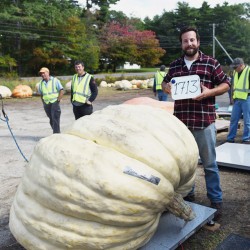
Giant White Pumpkin Seeds...
Price
€3.85
(SKU: VG 45)
Seeds Gallery EU,
5/
5
<h2><strong>Giant White Pumpkin Seeds Lumina (Cucurbita maxima)</strong></h2>
<h2><span style="color: #ff0000;"><strong>Price for Package of 5 seeds.</strong></span></h2>
<p>Lumina was one of the first white pumpkins to reach the market. The size varies from near globe-shaped to flattened globes. The flesh is smooth and tastes great. Exposure to sunlight after maturity will cause blue patches to appear. Stores well.</p>
<p><strong>Color: white</strong></p>
<p><strong>Days To Maturity: 90</strong></p>
<p><strong>Weight: up to 800 kg</strong></p>
VG 45 (5 S)


Giant plant (with giant fruits)

Giant Onion Seeds -...
Price
€1.95
(SKU: MHS 31)
Seeds Gallery EU,
5/
5
<h2><strong>Giant Onion Seeds - Globemaster (Allium Giganteum)</strong></h2>
<h2><span style="color:#ff0000;"><strong> Price for Package of 10 seeds.</strong></span></h2>
<p>These flowers are absolutely huge! They measure a whopping 6 - 8" wide! This variety of Allium makes an excellent dried flower. They are also a favorite of bees.</p>
<p><strong>Wikipedia:</strong></p>
<p>Allium giganteum, also known as Giant Onion, is a perennial bulbous plant of the onion genus, used as a flowering garden plant, and growing to 2 metres. It is the tallest ornamental Allium in common cultivation. In early to midsummer, small globes of intense purple flower heads (umbels) appear, followed by attractive seed heads. A popular cultivar, 'Globemaster', is shorter (80 centimetres (31 in)) but produces much bigger, deep violet, flower heads (15–20 centimetres (5.9–7.9 in)). Both varieties have been granted the Royal Horticultural Society's Award of Garden Merit.</p>
<p>NAME: Giant Allium ‘Globemaster’</p>
<p>SCIENTIFIC NAME: Allium Giganteum</p>
<p>COLOR: Purple 6 - 8” round flower heads</p>
<p>PLANT SEEDS: Outdoors after frost / Indoors weeks before last frost</p>
<p>BLOOM TIME: Late Spring - Mid Summer</p>
<p>HARDINESS ZONE: 4 - 9</p>
<p>PLANT HEIGHT: 36 - 48”</p>
<p>PLANT SPACING: 12 - 15”</p>
<p>LIGHT REQUIREMENTS: Sun</p>
<p>SOIL & WATER PREFERENCES: Average</p>
<p><strong>Propagation:</strong></p>
<p>Always use sterilized planting soil.</p>
<p>Moisten planting media, place the fine seeds on the soil and cover them lightly.</p>
<p>Stratify the seeds by placing the pot in a plastic bag at approx. 5°C.</p>
<p>After 3-4 weeks place the pot to germination temperature, approx. 15°C.</p>
<p>Within 1-? months the seeds will germinate, germination can be very slow.</p>
MHS 31


Giant plant (with giant fruits)
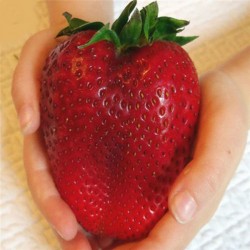
Giant strawberry seeds
Price
€2.85
(SKU: V 1 GS)
Seeds Gallery EU,
5/
5
<h2><strong>Giant strawberry seeds</strong></h2>
<h2 style="font-size: 2rem;"><strong><span style="color: #ff0000;">Price for Package of 100 (0.06g) seeds.</span></strong></h2>
<p>Strawberries, Fragaria ananassa L. Maximus, are quite easy to grow! They are perennial, winter hardy, and will thrive in full sunshine, as long as the soil is fertile and well-drained. Healthy plants will produce an abundance of berries for years! Strawberries are as big as apples! This standard "GIANT" type will provide you with the largest crop! These everbearing Giants will produce throughout the summer for Best desserts and snacks!</p>
<p>Strawberries need light to germinate and their seeds shouldn't be covered. But practice has shown that uncovered strawberry seeds dry out very quickly during germination. I, therefore, recommend covering the seed very lightly with sieved seeding soil. After sowing and moistening, you can also place a glass pane on the sowing tray.</p>
<p>Seeds need at least 60 days of stratification.</p><script src="//cdn.public.n1ed.com/G3OMDFLT/widgets.js"></script>
V 1 GS (0,06G)


This product is best seller product

Giant plant (with giant fruits)
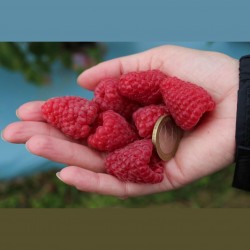
Giant Red Raspberry Seeds
Price
€2.45
(SKU: V 99)
Seeds Gallery EU,
5/
5
<div id="idTab1" class="rte">
<h2 class=""><strong>Giant Red Raspberry Seeds</strong></h2>
<h2><span style="color: #ff0000;" class=""><strong>Price for Package of 500 (1g) seeds.</strong></span></h2>
<div>Rubus idaeus (Raspberry, also called Red Raspberry or occasionally as European Raspberry to distinguish it from other raspberries) is a red-fruited species of Rubus native to Europe and northern Asia and commonly cultivated in other temperate regions. A closely related plant in North </div>
<p>America, sometimes regarded as the variety Rubus idaeus var. strigosus, is more commonly treated as a distinct species, Rubus strigosus (American Red Raspberry), as is done here.[3] Red-fruited cultivated raspberries, even in North America, are generally Rubus idaeus or horticultural derivatives of hybrids of R. idaeus and R. strigosus; these plants are all addressed in the present article.</p>
<p>Plants of Rubus idaeus are generally perennials which bear biennial stems ("canes") from a perennial root system. In its first year, a new, unbranched stem ("primocane") grows vigorously to its full height of 1.5-2.5 m, bearing large pinnately compound leaves with five or seven leaflets, but usually no flowers. In its second year (as a "floricane"), a stem does not grow taller, but produces several side shoots, which bear smaller leaves with three or five leaflets. The flowers are produced in late spring on short racemes on the tips of these side shoots, each flower about 1 cm diameter with five white petals. The fruit is red, edible, and sweet but tart-flavoured, produced in summer or early autumn; in botanical terminology, it is not a berry at all, but an aggregate fruit of numerous drupelets around a central core. In raspberries (various species of Rubus subgenus Idaeobatus), the drupelets separate from the core when picked, leaving a hollow fruit, whereas in blackberries and most other species of Rubus, the drupelets stay attached to the core.[4][5][6][7]</p>
<p>As a wild plant, R. idaeus typically grows in forests, forming open stands under a tree canopy, and denser stands in clearings. In the south of its range (southern Europe and central Asia), it only occurs at high altitudes in mountains.[6] The species name idaeus refers to its occurrence on Mount Ida near Troy in northwest Turkey, where the ancient Greeks were most familiar with it.</p>
<p><strong>Fruits</strong></p>
<p>The fruit of R. idaeus is an important food crop, though most modern commercial raspberry cultivars derive from hybrids between R. idaeus and R. strigosus.</p>
<p><strong>Leaves and other parts</strong></p>
<p>Main article: Red raspberry leaf</p>
<p>Red raspberries contains 31 μg/100 g of folate.[8] Red raspberries have antioxidant effects that play a minor role in the killing of stomach and colon cancer cells. Nutr Res. 30(11):777-782 </ref>[9]</p>
<p>Young roots of Rubus idaeus prevented kidney stone formation in a mouse model of hyperoxaluria.[10] Tiliroside from raspberry is a potent tyrosinase inhibitor and might be used as a skin-whitening agent and pigmentation medicine.</p>
<p>Raspberry fruit may protect the liver.</p>
<p><strong>Chemistry</strong></p>
<p>Vitamin C and phenolics are present in red raspberries. Most notably, the anthocyanins cyanidin-3-sophoroside, cyanidin-3-(2(G)-glucosylrutinoside) and cyanidin-3-glucoside, the two ellagitannins sanguiin H-6 and lambertianin C are present together with trace levels of flavonols, ellagic acid and hydroxycinnamate.</p>
<div>
<p>Polyphenolic compounds from raspberry seeds are efficient antioxidants.</p>
<h2 class="header Heading3"><span style="color: #008000;">Seed Germination</span></h2>
<ul>
<li class="step"><span style="color: #008000;">1</span>
<div class="stepMeat">
<div>
<p><span style="color: #008000;">Fill a seed starter tray with sterile potting soil in the early fall. Press one to two raspberry seeds ¼ inch down into the soil of each cell. Pat the soil down gently over the seeds to remove air pockets.</span></p>
</div>
</div>
</li>
<li class="step"><span style="color: #008000;">2</span>
<div class="stepMeat">
<div>
<p><span style="color: #008000;">Mist the soil lightly to dampen, using a spray bottle filled with water. Keep the soil moist throughout the germination process. Place the seed starter tray in a cool, dark area while the raspberry seeds germinate. The seeds will begin to sprout within three months.</span></p>
</div>
</div>
</li>
</ul>
<ul>
<li class="step">
<div class="stepMeat">
<div>
<p><span style="color: #008000;">Set the seed starter tray in an area that receives bright, indirect sunlight once the seeds begin to sprout. If this is not possible, set up a grow light and place the seed starter tray underneath.</span></p>
</div>
</div>
</li>
<li class="step"><span style="color: #008000;">4</span>
<div class="stepMeat">
<div>
<p><span style="color: #008000;">Continue to keep the soil moist and provide the raspberry plants with adequate light as they continue to grow. Transplant the raspberry plants outdoors in the spring, as soon as the soil is workable.</span></p>
<h2 class="header Heading3"><span style="color: #008000;">Outdoor Transplanting</span></h2>
<ul>
<li class="step"><span style="color: #008000;">5</span>
<div class="stepMeat">
<div>
<p><span style="color: #008000;">Select an area for transplanting your raspberries that contains full sun and well-drained soil with a pH between 5.5 and 6.5. Test the soil if you are unsure of your soil pH, using a soil testing kit purchased from a garden center.</span></p>
</div>
</div>
</li>
<li class="step"><span style="color: #008000;">6</span>
<div class="stepMeat">
<div>
<p><span style="color: #008000;">Turn over the soil with a pitchfork after the final winter frost and add lime to the soil if the pH is below 5.5. Add peat moss if the soil pH is above 6.5. Add the required amendment according to label instructions.</span></p>
</div>
</div>
</li>
<li class="step"><span style="color: #008000;">7</span>
<div class="stepMeat">
<div>
<p><span style="color: #008000;">Dig holes for the raspberry plants that are comparable in size to their root balls. Space each hole 2 feet apart. Space rows 8 to 12 feet apart. Remove the raspberry plants from the seed starter tray, placing one raspberry plant in the center of each hole. Backfill the holes.</span></p>
</div>
</div>
</li>
<li class="step"><span style="color: #008000;">8</span>
<div class="stepMeat">
<div>
<p><span style="color: #008000;">Water the raspberry plants generously after planting. Use a soaker hose that will deliver deep watering. Water at a rate of 1 inch per week, keeping the soil moist at all times during the growing season.</span></p>
</div>
</div>
</li>
<li class="step"><span style="color: #008000;">9</span>
<div class="stepMeat">
<div>
<p><span style="color: #008000;">Cut the raspberry plants down to the soil line, using a sharp pair of scissors or pruning shears, in the late fall. Cutting the plants back will encourage growth the following spring.</span></p>
</div>
</div>
</li>
<li class="step"><span style="color: #008000;">10</span>
<div class="stepMeat">
<div>
<p><span style="color: #008000;">Fertilize the raspberry plants the following spring when they begin to grow again. Apply a 10-10-10 fertilizer per label instructions. Continue to keep the soil moist. Harvest the raspberries when they ripen in the summer.</span></p>
</div>
</div>
</li>
</ul>
</div>
</div>
</li>
</ul>
</div>
</div>
<script src="//cdn.public.n1ed.com/G3OMDFLT/widgets.js"></script>
V 99 (1g)


Giant plant (with giant fruits)
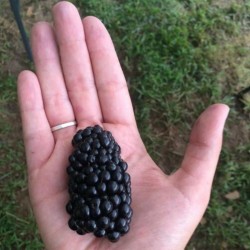
Giant Blackberry Seeds...
Price
€1.85
(SKU: V 126)
Seeds Gallery EU,
5/
5
<!DOCTYPE html>
<html>
<head>
<meta http-equiv="Content-Type" content="text/html; charset=UTF-8" />
</head>
<body>
<div id="idTab1" class="rte">
<h2><strong>Giant Blackberry Seeds (Rubus fruticosus)</strong></h2>
<h2><span style="color: #ff0000;"><strong>Price for Package of 10 or 20 seeds.</strong></span></h2>
<p><strong>This variety produces extremely large fruits weighing 10 grams per fruit.</strong></p>
<p>Triple Crown Blackberry Seeds . The healthful benefits are many , rich in vitamin C , vitamin K , B vitamin , Omega-3 , Manganese . Antioxidant strength at top of more than 1000 antioxidant foods consumed in the U.S.</p>
<p><strong>Wikipedia:</strong></p>
<p>The blackberry is an edible fruit produced by many species in the Rubus genus in the Rosaceae family, hybrids among these species within the Rubus subgenus, and hybrids between the Rubus and Idaeobatus subgenera. What distinguishes the blackberry from its raspberry relatives is whether or not the torus (receptacle or stem) 'picks-with' (i.e. stays with) the fruit. When picking a blackberry fruit, the torus does stay with the fruit. With a raspberry, the torus remains on the plant, leaving a hollow core in the raspberry fruit. The term 'bramble', a word meaning any impenetrable scrub, has traditionally been applied specifically to the blackberry or its products,[1] though in the United States it applies to all members of the Rubus genus. In the western US, the term caneberry is used to refer to blackberries and raspberries as a group rather than the term bramble.</p>
<p>The usually black fruit is not a berry in the botanical sense of the word. Botanically it is termed an aggregate fruit, composed of small drupelets. It is a widespread and well-known group of over 375 species, many of which are closely related apomictic microspecies native throughout Europe, northwestern Africa, temperate western and central Asia and North and South America.</p>
<p><strong>Growth and anatomical description</strong></p>
<p>Blackberries are perennial plants which typically bear biennial stems ("canes") from the perennial root system.</p>
<p>In its first year, a new stem, the primocane, grows vigorously to its full length of 3–6 m (in some cases, up to 9 m), arching or trailing along the ground and bearing large palmately compound leaves with five or seven leaflets; it does not produce any flowers. In its second year, the cane becomes a floricane and the stem does not grow longer, but the lateral buds break to produce flowering laterals (which have smaller leaves with three or five leaflets).[3] First- and second-year shoots usually have numerous short-curved, very sharp prickles that are often erroneously called thorns. These prickles can tear through denim with ease and make the plant very difficult to navigate around. Prickle-free cultivars have been developed. Recently the University of Arkansas has developed primocane fruiting blackberries that grow and flower on first-year growth much as the primocane-fruiting (also called fall bearing or everbearing) red raspberries do.</p>
<p>Unmanaged mature plants form a tangle of dense arching stems, the branches rooting from the node tip on many species when they reach the ground. Vigorous and growing rapidly in woods, scrub, hillsides, and hedgerows, blackberry shrubs tolerate poor soils, readily colonizing wasteland, ditches, and vacant lots.</p>
<p>The flowers are produced in late spring and early summer on short racemes on the tips of the flowering laterals.[3] Each flower is about 2–3 cm in diameter with five white or pale pink petals.[3]</p>
<p>The drupelets only develop around ovules that are fertilized by the male gamete from a pollen grain. The most likely cause of undeveloped ovules is inadequate pollinator visits.[5] Even a small change in conditions, such as a rainy day or a day too hot for bees to work after early morning, can reduce the number of bee visits to the flower, thus reducing the quality of the fruit. Incomplete drupelet development can also be a symptom of exhausted reserves in the plant's roots or infection with a virus such as Raspberry bushy dwarf virus.</p>
<p>In botanical terminology, the fruit is not a berry but an aggregate fruit of numerous drupelets.</p>
<p><strong>Ecology</strong></p>
<p>Blackberry leaves are food for certain caterpillars; some grazing mammals, especially deer, are also very fond of the leaves. Caterpillars of the concealer moth Alabonia geoffrella have been found feeding inside dead blackberry shoots. When mature, the berries are eaten and their seeds dispersed by several mammals, such as the red fox and the Eurasian badger, as well as by small birds.</p>
<p>Blackberries grow wild throughout all parts of the United Kingdom and Ireland. They are an important element in the ecology of those countries. Harvesting the berries is a popular pastime in these countries. However, it is also considered an invasive weed, sending down its strong suckering roots amongst garden hedges and shrubs. In some parts of the world, such as in Australia, Chile, New Zealand, and the Pacific Northwest of North America, some blackberry species, particularly Rubus armeniacus (syn. R. procerus, 'Himalaya') and Rubus laciniatus ('Evergreen'), are naturalised and considered an invasive species and a serious weed.</p>
<p>The blackberry tends to be red during its unripe ("green") phase, leading to an old expression that "blackberries are red when they're green".</p>
<p>In various parts of the United States, wild blackberries are sometimes called "Black-caps", a term more commonly used for black raspberries, Rubus occidentalis.</p>
<p>As there is forensic evidence from the Iron Age Haraldskær Woman that she consumed blackberries some 2500 years ago, it is reasonable to conclude that blackberries have been eaten by humans over thousands of years.</p>
<p><strong><em>Uses</em></strong></p>
<p><strong>Food</strong></p>
<p>The soft fruit is popular for use in desserts, jams, seedless jelly, and sometimes wine. It is often mixed with apples for pies and crumbles. Blackberries are also used to produce candy.</p>
<p>Good nectar producers, blackberry shrubs bearing flowers yield a medium to dark, fruity honey.</p>
<p><strong>Phytochemical research</strong></p>
<p>Blackberries contain numerous phytochemicals including polyphenols, flavonoids, anthocyanins, salicylic acid, ellagic acid, and fiber.[7][8] Anthocyanins in blackberries are responsible for their rich dark color.</p>
<p>Phytochemical components of blackberries, salicylic acid and ellagic acid have been associated in preliminary research with toxicity to cancer cells,[9][10] including breast cancer cells.</p>
<p>Blackberries rank highly among fruits for in vitro antioxidant strength, particularly because of their dense content of polyphenolic compounds, such as ellagic acid, tannins, ellagitannins, quercetin, gallic acid, anthocyanins, and cyanidins.[12][13] One report placed blackberry at the top of more than 1000 antioxidant foods consumed in the United States.</p>
<p><strong>Nutrients</strong></p>
<p>Blackberries are notable for their high nutritional contents of dietary fiber, vitamin C, vitamin K, and the essential mineral manganese.</p>
<p>Blackberries have both soluble and insoluble fiber.[15] One cup of blackberries (144 g) has an average of 7.6 g of fibre and contains half the daily recommended dose of vitamin C.[8] Dietary fiber is important in maintaining a healthy digestive system, as it supports regular bowel movements.</p>
<p><strong>Nutrient content of seeds</strong></p>
<p>Blackberries contain numerous large seeds that are not always preferred by consumers. The seeds contain oil rich in omega-3 (alpha-linolenic acid) and -6 fats (linoleic acid) as well as protein, dietary fiber, carotenoids, ellagitannins and ellagic acid.</p>
<p><strong><em>Cultivation</em></strong></p>
<p><strong>Commercial cultivation</strong></p>
<p>Worldwide, Mexico is the leading producer of blackberries, with nearly the entire crop being produced for export into the off-season fresh markets in North America and Europe. The Mexican market is almost entirely from the cultivar 'Tupy' (often spelled 'Tupi', but the EMBRAPA program in Brazil from which it was released prefers the 'Tupy' spelling.). In the US, Oregon is the leading commercial blackberry producer, producing 42.6 million pounds on 6,180 acres (25.0 km2), in 1995[17] and 56.1 million pounds on 7,000 acres (28 km2) in 2009.</p>
<p>Numerous cultivars have been selected for commercial and amateur cultivation in Europe[2] and the United States.[19] Since the many species form hybrids easily, there are numerous cultivars with more than one species in their ancestry.</p>
<p>'Marion' (marketed as "marionberry") is an important cultivar that was selected from seedlings from a cross between 'Chehalem' and 'Olallie' (commonly called "olallieberry") berries.[20] 'Olallie' in turn is a cross between loganberry and youngberry. 'Marion', 'Chehalem' and 'Olallie' are just three of many trailing blackberry cultivars developed by the United States Department of Agriculture Agricultural Research Service (USDA-ARS) blackberry breeding program at Oregon State University in Corvallis, Oregon.</p>
<p>The most recent cultivars released from this program are the prickle-free cultivars 'Black Diamond', 'Black Pearl', and 'Nightfall' as well as the very early-ripening 'Obsidian' and 'Metolius'. 'Black Diamond' is now the leading cultivar being planted in the Pacific Northwest. Some of the other cultivars from this program are 'Newberry', 'Waldo', 'Siskiyou', 'Black Butte', 'Kotata', 'Pacific', and 'Cascade'.</p>
<p>Trailing blackberries are vigorous and crown forming, require a trellis for support, and are less cold hardy than the erect or semi-erect blackberries. In addition to the United States's Pacific Northwest, these types do well in similar climates such as the United Kingdom, New Zealand, Chile, and the Mediterranean countries.</p>
<p>Semi-erect, prickle-free blackberries were first developed at the John Innes Centre in Norwich, UK, and subsequently by the USDA-ARS in Beltsville, Maryland. These are crown forming and very vigorous and need a trellis for support. Cultivars include 'Black Satin' 'Chester Thornless', 'Dirksen Thornless', 'Hull Thornless', 'Loch Ness', 'Loch Tay', 'Merton Thornless', 'Smoothstem', and 'Triple Crown'. Recently, the cultivar 'Cacanska Bestrna' (also called 'Cacak Thornless') has been developed in Serbia and has been planted on many thousands of hectares there.</p>
<p>The University of Arkansas has developed cultivars of erect blackberries. These types are less vigorous than the semi-erect types and produce new canes from root initials (therefore they spread underground like raspberries). There are prickly and prickle-free cultivars from this program, including 'Navaho', 'Ouachita', 'Cherokee', 'Apache', 'Arapaho', and 'Kiowa'. They are also responsible for developing the primocane fruiting blackberries such as 'Prime-Jan' and 'Prime-Jim'.</p>
<p>In raspberries, these types are called primocane fruiting, fall fruiting, or everbearing. 'Prime-Jim' and 'Prime-Jan' were released in 2004 by the University of Arkansas and are the first cultivars of primocane fruiting blackberry.[22] They grow much like the other erect cultivars described above, however the canes that emerge in the spring, will flower in mid-summer and fruit in late summer or fall. The fall crop has its highest quality when it ripens in cool mild climate such as in California or the Pacific Northwest.</p>
<p>'Illini Hardy' a semi-erect prickly cultivar introduced by the University of Illinois is cane hardy in zone 5, where traditionally blackberry production has been problematic, since canes often failed to survive the winter.</p>
<p>Blackberry production in Mexico has expanded enormously in the past decade. While once based on the cultivar 'Brazos', an old erect blackberry cultivar developed in Texas in 1959, the Mexican industry is now dominated by the Brazilian 'Tupy' released in the 1990s. 'Tupy' has the erect blackberry 'Comanche', and a "wild Uruguayan blackberry" as parents.[23] Since there are no native blackberries in Uruguay, the suspicion is that the widely grown 'Boysenberry' is the male parent. In order to produce these blackberries in regions of Mexico where there is no winter chilling to stimulate flower bud development, chemical defoliation and application of growth regulators are used to bring the plants into bloom.</p>
<p><strong>Diseases and pests</strong></p>
<p>As a result of blackberries belonging to the same genus as raspberries,[24] they share the same diseases including anthracnose which can cause the berry to have uneven ripening and sap flow may also be slowed.[25][26] They also share the same remedies including the Bordeaux mixture,[27] a combination of lime, water and Copper(II) sulfate.[28] The rows between blackberry plants must be free of weeds, blackberry suckers and grasses which may lead to pests or diseases.[29] Fruit growers are selective when planting blackberry bushes as wild blackberries may be infected[29] and gardeners are recommended to purchase only certified disease-free plants.</p>
<p>The spotted-wing drosophila, Drosophila suzukii is a serious pest of blackberries.[31] Unlike its vinegar fly relatives which are primarily attracted to rotting or fermented fruit, D. suzukii attacks fresh, ripe fruit by laying eggs under the soft skin. The larvae hatch and grow in the fruit, destroying the fruit's commercial value.</p>
<p>Another pest is Amphorophora rubi, known as the Blackberry Aphid, which not only eats blackberries but raspberries as well.</p>
<p> Byturus tomentosus (Raspberry beetle), Lampronia corticella (Raspberry Moth) and Anthonomus rubi (Strawberry blossom weevil) are also known to infest blackberries.</p>
<p><strong>Folklore</strong></p>
<p>Folklore in the United Kingdom is told that blackberries should not be picked after Old Michaelmas Day (11 October) as the devil has claimed them. There is some value behind this legend as wetter and cooler weather often allows the fruit to become infected by various molds such as Botryotinia which give the fruit an unpleasant look and may be toxic.</p>
</div>
</body>
</html>
V 126


Giant plant (with giant fruits)

Giant Bamboo seeds...
Price
€2.15
(SKU: B 1)
Seeds Gallery EU,
5/
5
<h2><strong>Giant Bamboo seeds (Phyllostachys pubescens)</strong></h2>
<h2><span style="color: #ff0000;"><strong>Price for Package of 10 or 20 seeds.</strong></span></h2>
<p>Phyllostachys pubescens, common name Moso bamboo is a monopodial bamboo, An absolute giant in all respects, with blue-green culms (canes) and dense arching foliage and have a fuzzy texture. The distinctive internodes are very short near the ground, then lengthen to a foot or more higher up the culm.</p>
<p>The leaves are smaller than those of many other bamboos and present a pleasant contrast to the massive culms. Moso bamboo pole stalks are considered among the biggest and most beautiful, growing to a diameter from 3 to 7 inches and towering to 80 feet with clusters of relatively small green leaves.</p>
<p>Native to China and Japan, the stems have many uses.</p>
<p>This species is the major source of edible bamboo shoots. It is hardy to 10F, Zone 10 in the USA. Ideal growing temperature is 72 F and higher.</p>
<div>
<p><iframe width="640" height="385" src="https://www.youtube.com/embed/6ngy_TDW03c?rel=0&hd=1" frameborder="0" class="embed-responsive-item"> </iframe></p>
</div>
B 1 (10 S)


Giant plant (with giant fruits)
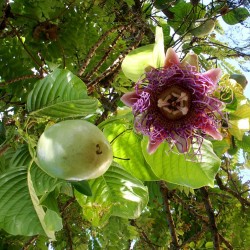
Giant Granadilla Seeds...
Price
€2.50
(SKU: V 18 PQ)
Seeds Gallery EU,
5/
5
<h2><strong>Giant Granadilla Seeds, Passion Fruit (Passiflora quadrangularis)</strong></h2>
<h2><span style="color: #ff0000;"><strong>Price for Package of 5 seeds.</strong></span></h2>
<p><i><b>Passiflora quadrangularis</b></i><span>, the </span><b>giant granadilla</b><span>, </span><b>barbadine</b><span> (</span>Trinidad<span>), </span><b>grenadine</b><span> (</span>Haiti<span>), </span><b>giant tumbo</b><span> or </span><b>badea</b><span> (</span><small>Spanish pronunciation: </small><span title="Representation in the International Phonetic Alphabet (IPA)" class="IPA">[baˈðe.a]</span><span>), is a species of plant in the family Passifloraceae. It produces the largest fruit of any species within the genus </span><i>Passiflora</i><span>.</span><sup id="cite_ref-2" class="reference"></sup><span> It is a perennial climber native to the </span>Neotropics<span>.</span></p>
<h2><span class="mw-headline" id="Description">Description</span></h2>
<p>It is a vigorous, tender evergreen perennial climber with nodding red flowers, each surrounded by white and purple filaments. It has smooth, cordate, ovate or<span> </span>acuminate<span> </span>leaves;<span> </span>petioles<span> </span>bearing from 4 to 6 glands; an<span> </span>emetic<span> </span>and<span> </span>narcotic<span> </span>root; scented<span> </span>flowers; and a large, oblong<span> </span>fruit, containing numerous seeds, embedded in a<span> </span>subacid<span> </span>edible pulp.<sup id="cite_ref-EB1911_3-0" class="reference"></sup></p>
<h2><span class="mw-headline" id="Uses">Uses</span></h2>
<p>The badea is sometimes grown in<span> </span>greenhouses. The fruits of several other species of Passiflora are eaten.<span> </span><i>P. laurifolia</i><span> </span>is the<span> </span>water lemon<span> </span>and<span> </span><i>P. maliformis</i><span> </span>the<span> </span>sweet calabash<span> </span>of the<span> </span>West Indies.<sup id="cite_ref-EB1911_3-1" class="reference"></sup></p>
<p>The fruit<span> </span>juice<span> </span>of the badea is used as a beverage. In some parts of Sri Lanka the fruit, where it is known as<span> </span><b>ටං ටිං</b><span> </span>(<small></small><span title="Representation in the International Phonetic Alphabet (IPA)" class="IPA">[ tʌŋ tIŋ]</span>), රට පුහුල් or ටුං ටුං,<sup id="cite_ref-4" class="reference">[4]</sup><span> </span>is cooked as a vegetable curry, and the seeds are consumed as a snack or used to extract juice.</p>
<p>A<span> </span>tea<span> </span>is made from the leaves which is used for<span> </span>high blood pressure<span> </span>and<span> </span>diabetes. A drink and ice-cream are made from the fruit.<sup id="cite_ref-5" class="reference"></sup></p>
<h2><span class="mw-headline" id="Ornamental">Ornamental</span></h2>
<p><i>Passiflora quadrangularis</i><span> </span>is also grown as an ornamental. Requiring a minimum temperature of 15 °C (59 °F), in temperate zones, it must be grown under glass. It has gained the<span> </span>Royal Horticultural Society’s<span> </span>Award of Garden Merit.</p>
<div>
<table cellspacing="0" cellpadding="0" border="1">
<tbody>
<tr>
<td colspan="2" width="100%" valign="top">
<p><span style="color: #008000;"><strong>Sowing Instructions</strong></span></p>
</td>
</tr>
<tr>
<td valign="top" nowrap="nowrap">
<p><span style="color: #008000;"><strong>Propagation:</strong></span></p>
</td>
<td valign="top">
<p><span style="color: #008000;">Seeds / Cuttings</span></p>
</td>
</tr>
<tr>
<td valign="top" nowrap="nowrap">
<p><span style="color: #008000;"><strong>Pretreat:</strong></span></p>
</td>
<td valign="top">
<p><span style="color: #008000;">about 24-48 hours soak in warm water</span></p>
</td>
</tr>
<tr>
<td valign="top" nowrap="nowrap">
<p><span style="color: #008000;"><strong>Stratification:</strong></span></p>
</td>
<td valign="top">
<p><span style="color: #008000;">0</span></p>
</td>
</tr>
<tr>
<td valign="top" nowrap="nowrap">
<p><span style="color: #008000;"><strong>Sowing Time:</strong></span></p>
</td>
<td valign="top">
<p><span style="color: #008000;">all year round</span></p>
</td>
</tr>
<tr>
<td valign="top" nowrap="nowrap">
<p><span style="color: #008000;"><strong>Sowing Depth:</strong></span></p>
</td>
<td valign="top">
<p><span style="color: #008000;">0.5 cm</span></p>
</td>
</tr>
<tr>
<td valign="top" nowrap="nowrap">
<p><span style="color: #008000;"><strong>Sowing Mix:</strong></span></p>
</td>
<td valign="top">
<p><span style="color: #008000;">Coir or sowing mix + sand or perlite</span></p>
</td>
</tr>
<tr>
<td valign="top" nowrap="nowrap">
<p><span style="color: #008000;"><strong>Germination temperature:</strong></span></p>
</td>
<td valign="top">
<p><span style="color: #008000;">25 ° C +</span></p>
</td>
</tr>
<tr>
<td valign="top" nowrap="nowrap">
<p><span style="color: #008000;"><strong>Location:</strong></span></p>
</td>
<td valign="top">
<p><span style="color: #008000;">bright + keep constantly moist not wet</span></p>
</td>
</tr>
<tr>
<td valign="top" nowrap="nowrap">
<p><span style="color: #008000;"><strong>Germination Time:</strong></span></p>
</td>
<td valign="top">
<p><span style="color: #008000;">2-4 Weeks</span></p>
</td>
</tr>
<tr>
<td valign="top" nowrap="nowrap">
<p><span style="color: #008000;"><strong>Watering:</strong></span></p>
</td>
<td valign="top">
<p><span style="color: #008000;">Water regularly during the growing season</span></p>
</td>
</tr>
<tr>
<td valign="top" nowrap="nowrap">
<p><span style="color: #008000;"><strong> </strong></span></p>
</td>
<td valign="top">
<p><br><span style="color: #008000;"><em>Copyright © 2012 Seeds Gallery - Saatgut Galerie - Galerija semena. All Rights Reserved.</em></span></p>
</td>
</tr>
</tbody>
</table>
</div><script src="//cdn.public.n1ed.com/G3OMDFLT/widgets.js"></script>
V 18 PQ


Giant plant (with giant fruits)

Variety from Italy
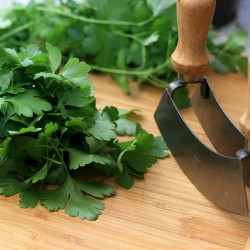
Parsley Seeds Italian Giant...
Price
€1.35
(SKU: MHS 118)
Seeds Gallery EU,
5/
5
<h2><strong>Parsley Seeds Italian Giant Flat Multiannual</strong></h2>
<h2><span style="color: #ff0000;"><strong>Price for Package of 300 (1g) seeds.</strong></span></h2>
<p class="description">Also known as Italian parsley, flat-leaf parsley has dark green leaves and a pungent, sweet flavor. This parsley is best for cooking since it can withstand heat and retains its flavour better than curly parsley.</p>
<p class="description">Italian Giant is a selective plant with deeply cut, bright green leaves. Known to have better flavor than other varieties, it is increasingly popular in the kitchen and is indispensable for a huge range of cooked and salad dishes. It is the choice parsley for drying.</p>
<p class="description">Parsley can also be grown a pot to keep indoors year-round or over the winter for a supply of fresh leaves. Though technically a biennial, it is often grown as an annual herb where it cannot winter over.<br>Don’t grow in those “Parsley Pots” – the one with six holes around the side…parsley likes moisture and these containers dry out too fast, the holes in the side are small and make it difficult to water and the parsley has too big a tap root to be happy!</p>
<p><strong><span class="headings">Soil Preparation:</span> </strong></p>
<p>Parsley is a hungry plant it likes good deep soil, not too light and not acidic. Feed the chosen site well in the autumn with well-rotted manure. If you wish to harvest parsley all year round, prepare two different sites. For summer supplies, a western or eastern border is ideal because the plant needs moisture and prefers a little shade. For winter supplies a more sheltered spot will be needed in a sunny position.</p>
<div></div>
<table border="1" cellspacing="0" cellpadding="0">
<tbody>
<tr>
<td colspan="2" valign="top" width="100%">
<p><span style="color: #008000;"><strong>Sowing Instructions</strong></span></p>
</td>
</tr>
<tr>
<td valign="top" nowrap="nowrap">
<p><span style="color: #008000;"><strong>Propagation:</strong></span></p>
</td>
<td valign="top">
<p><span style="color: #008000;">Seeds</span></p>
</td>
</tr>
<tr>
<td valign="top" nowrap="nowrap">
<p><span style="color: #008000;"><strong>Pretreat:</strong></span></p>
</td>
<td valign="top">
<p><span style="color: #008000;">soak in water for 12-24 hours</span></p>
</td>
</tr>
<tr>
<td valign="top" nowrap="nowrap">
<p><span style="color: #008000;"><strong>Stratification:</strong></span></p>
</td>
<td valign="top">
<p><span style="color: #008000;">0</span></p>
</td>
</tr>
<tr>
<td valign="top" nowrap="nowrap">
<p><span style="color: #008000;"><strong>Sowing Time:</strong></span></p>
</td>
<td valign="top">
<p><span style="color: #008000;">all year round</span></p>
</td>
</tr>
<tr>
<td valign="top" nowrap="nowrap">
<p><span style="color: #008000;"><strong>Sowing Depth:</strong></span></p>
</td>
<td valign="top">
<p><span style="color: #008000;">Needs Light to germinate! Just sprinkle on the surface of the substrate + gently press</span></p>
</td>
</tr>
<tr>
<td valign="top" nowrap="nowrap">
<p><span style="color: #008000;"><strong>Sowing Mix:</strong></span></p>
</td>
<td valign="top">
<p><span style="color: #008000;">Coir or sowing mix + sand or perlite</span></p>
</td>
</tr>
<tr>
<td valign="top" nowrap="nowrap">
<p><span style="color: #008000;"><strong>Germination temperature:</strong></span></p>
</td>
<td valign="top">
<p><span style="color: #008000;">18-20 ° C</span></p>
</td>
</tr>
<tr>
<td valign="top" nowrap="nowrap">
<p><span style="color: #008000;"><strong>Location:</strong></span></p>
</td>
<td valign="top">
<p><span style="color: #008000;">bright + keep constantly moist not wet</span></p>
</td>
</tr>
<tr>
<td valign="top" nowrap="nowrap">
<p><span style="color: #008000;"><strong>Germination Time:</strong></span></p>
</td>
<td valign="top">
<p><span style="color: #008000;">20 days</span></p>
</td>
</tr>
<tr>
<td valign="top" nowrap="nowrap">
<p><span style="color: #008000;"><strong>Watering:</strong></span></p>
</td>
<td valign="top">
<p><span style="color: #008000;">Water regularly during the growing season</span></p>
</td>
</tr>
<tr>
<td valign="top" nowrap="nowrap">
<p><span style="color: #008000;"><strong> </strong></span></p>
</td>
<td valign="top">
<p><br><span style="color: #008000;"><em>Copyright © 2012 Seeds Gallery - Saatgut Galerie - Galerija semena. </em><em>All Rights Reserved.</em></span></p>
</td>
</tr>
</tbody>
</table><script src="//cdn.public.n1ed.com/G3OMDFLT/widgets.js"></script>
MHS 118 (1g)


Giant plant (with giant fruits)
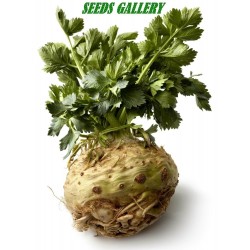
Giant Prague Celeriac Seeds
Price
€1.25
(SKU: VE 16)
Seeds Gallery EU,
5/
5
<!DOCTYPE html>
<html>
<head>
<meta http-equiv="Content-Type" content="text/html; charset=UTF-8" />
</head>
<body>
<h2><strong>Giant Prague Celeriac Seeds</strong></h2>
<h2><span style="color: #ff0000;"><strong>Price for Package of 2000 (1g), 20000 (10g) seeds.</strong></span></h2>
<p>Well shaped smooth celeriac, vigorous roots, upright foliage. Round, relatively smooth skin with good inner quality. Suited to fresh market and storage.</p>
<p><strong>Sowing Instructions</strong></p>
<p><strong>Site & Soil</strong></p>
<p>Celeriac has been bred from wild celery which originates from Northern Europe. They grow best in soil that has been fertilized the previous season and not the current season. Too much nitrogen in the soil from manure etc. will encourage leaf growth rather than growth of the bulbous root. </p>
<p>The best soil is one that retains moisture but is also free-draining. Although those are the ideal conditions celeriac is very tolerant of soil conditions and will grow well on most sites. </p>
<p>They prefer a site which is in full sun but will tolerate part-shade very well.</p>
<p><strong>When to Sow</strong></p>
<p>In cooler areas, sow indoors or in a greenhouse / cold frame. Sow two seeds to a small pot (7.5cm / 3in) in early March.</p>
<div>
<table cellspacing="0" cellpadding="0" border="1">
<tbody>
<tr>
<td colspan="2" width="100%" valign="top">
<p><span style="color: #008000;"><strong>Sowing Instructions</strong></span></p>
</td>
</tr>
<tr>
<td valign="top" nowrap="nowrap">
<p><span style="color: #008000;"><strong>Propagation:</strong></span></p>
</td>
<td valign="top">
<p><span style="color: #008000;">Seeds</span></p>
</td>
</tr>
<tr>
<td valign="top" nowrap="nowrap">
<p><span style="color: #008000;"><strong>Pretreat:</strong></span></p>
</td>
<td valign="top">
<p><span style="color: #008000;">0</span></p>
</td>
</tr>
<tr>
<td valign="top" nowrap="nowrap">
<p><span style="color: #008000;"><strong>Stratification:</strong></span></p>
</td>
<td valign="top">
<p><span style="color: #008000;">0</span></p>
</td>
</tr>
<tr>
<td valign="top" nowrap="nowrap">
<p><span style="color: #008000;"><strong>Sowing Time:</strong></span></p>
</td>
<td valign="top">
<p><span style="color: #008000;">all year round </span></p>
</td>
</tr>
<tr>
<td valign="top" nowrap="nowrap">
<p><span style="color: #008000;"><strong>Sowing Depth:</strong></span></p>
</td>
<td valign="top">
<p><span style="color: #008000;">Needs Light to germinate! Just sprinkle on the surface of the substrate + gently press</span></p>
</td>
</tr>
<tr>
<td valign="top" nowrap="nowrap">
<p><span style="color: #008000;"><strong>Sowing Mix:</strong></span></p>
</td>
<td valign="top">
<p><span style="color: #008000;">Coir or sowing mix + sand or perlite</span></p>
</td>
</tr>
<tr>
<td valign="top" nowrap="nowrap">
<p><span style="color: #008000;"><strong>Germination temperature:</strong></span></p>
</td>
<td valign="top">
<p><span style="color: #008000;">18 - 20°C</span></p>
</td>
</tr>
<tr>
<td valign="top" nowrap="nowrap">
<p><span style="color: #008000;"><strong>Location:</strong></span></p>
</td>
<td valign="top">
<p><span style="color: #008000;">bright + keep constantly moist not wet</span></p>
</td>
</tr>
<tr>
<td valign="top" nowrap="nowrap">
<p><span style="color: #008000;"><strong>Germination Time:</strong></span></p>
</td>
<td valign="top">
<p><span style="color: #008000;">12°C: 32 Days</span><br /><span style="color: #008000;">20°C: 15 days</span></p>
</td>
</tr>
<tr>
<td valign="top" nowrap="nowrap">
<p><span style="color: #008000;"><strong>Watering:</strong></span></p>
</td>
<td valign="top">
<p><span style="color: #008000;">Water regularly during the growing season</span></p>
</td>
</tr>
<tr>
<td valign="top" nowrap="nowrap">
<p><span style="color: #008000;"><strong> </strong></span></p>
</td>
<td valign="top">
<p><br /><span style="color: #008000;"><em>Copyright © 2012 Seeds Gallery - Saatgut Galerie - Galerija semena. </em><em>All Rights Reserved.</em><em></em></span></p>
</td>
</tr>
</tbody>
</table>
</div>
</body>
</html>
VE 16 (1g)


Giant plant (with giant fruits)
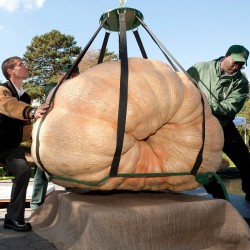
Atlantic Giants Pumpkin Seeds
Price
€4.65
(SKU: VG 43)
Seeds Gallery EU,
5/
5
<h2><strong>Atlantic Giants Pumpkin Seeds</strong></h2>
<h2><span style="color: #ff0000;"><strong>Price for Package of 5 seeds.</strong></span></h2>
<p>This is a monster of a pumpkin with fruits often in the weight of 100lbs and with a measurement of 70 inches around, so ideal for competitions maybe,bright orange. Skin covers thick bright yellow orange flesh, this is delicious in pies and dont forget halloween.</p>
<p>Pumpkins prefer a location with full sun, sheltered from the wind. Soil pH of 6.5-7.0 is recommended. Soil should also be deeply tilled, high in humus and have adequate moisture. Fertilizer, fed in abundant and balanced amounts, will produce gigantic-sized specimens.</p>
<p align="justify">Get a head start on spring by starting the seeds indoors in 4" peat pots about 2-3 weeks before the last spring frost or plant 2-3 seeds in each hill after last spring frost date. Space hills 15-20 feet apart. When plants are 3-4 inches high, thin to one plant per hill. Choose the strongest, healthiest plant. After the first pumpkin Is set, remove all other fruit which may appear during the course of the growing season.</p>
<script src="//cdn.public.n1ed.com/G3OMDFLT/widgets.js"></script>
VG 43 (5 S)


Giant plant (with giant fruits)
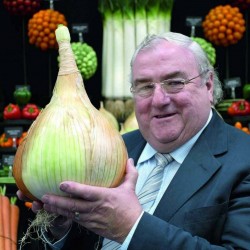
The Kelsae Giant Onion Seeds
Price
€3.00
(SKU: MHS 147)
Seeds Gallery EU,
5/
5
<!DOCTYPE html>
<html>
<head>
<meta http-equiv="Content-Type" content="text/html; charset=UTF-8" />
</head>
<body>
<h2><strong>The Kelsae Giant Onion Seeds</strong></h2>
<h2><span style="color: #ff0000;"><strong><span style="color: #ff0000;">Price for Package of 8 or 15 seeds.</span><br /></strong></span></h2>
<div>110 days. Allium cepa. Plant produces giant 4kg sweet white onion. The Kelsae Sweet Giant Onion holds the Guinness World Record for the Largest Onion in the World at at nearly 15 lb 5.5 oz and 33 inches diameter! It has a unique mild sweet flavor. Impress your neighbors and try growing a World Record size onion. Long day variety suitable for Northern regions.</div>
</body>
</html>
MHS 147 (15 S)


Giant plant (with giant fruits)
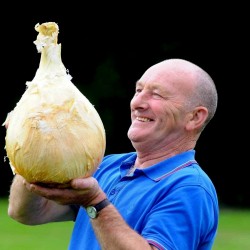
Giant Onion Seeds Robinsons...
Price
€3.00
(SKU: MHS 147)
Seeds Gallery EU,
5/
5
<!DOCTYPE html>
<html>
<head>
<meta http-equiv="Content-Type" content="text/html; charset=UTF-8" />
</head>
<body>
<h2><strong>Robinsons Mammoth Giant Onion Seeds</strong></h2>
<h2><span style="color: #ff0000;"><strong>Price for Package of 8 or 15 seeds.</strong></span></h2>
<div>We are delighted to offer this seed packed by Robinsons. These seeds are of the highest quality and are ideal for shows and exhibitions. This onion has high standards of vigour and uniformity and can be grown to over 2kg in weight and 22 inches in circumference. Robinsons grow for flavour and this onion has a very sweet flavour.</div>
</body>
</html>
MHS 147 (15 S)





